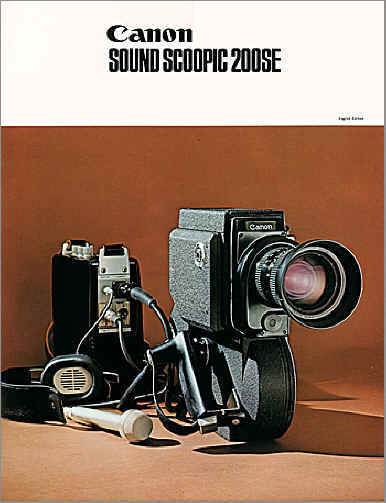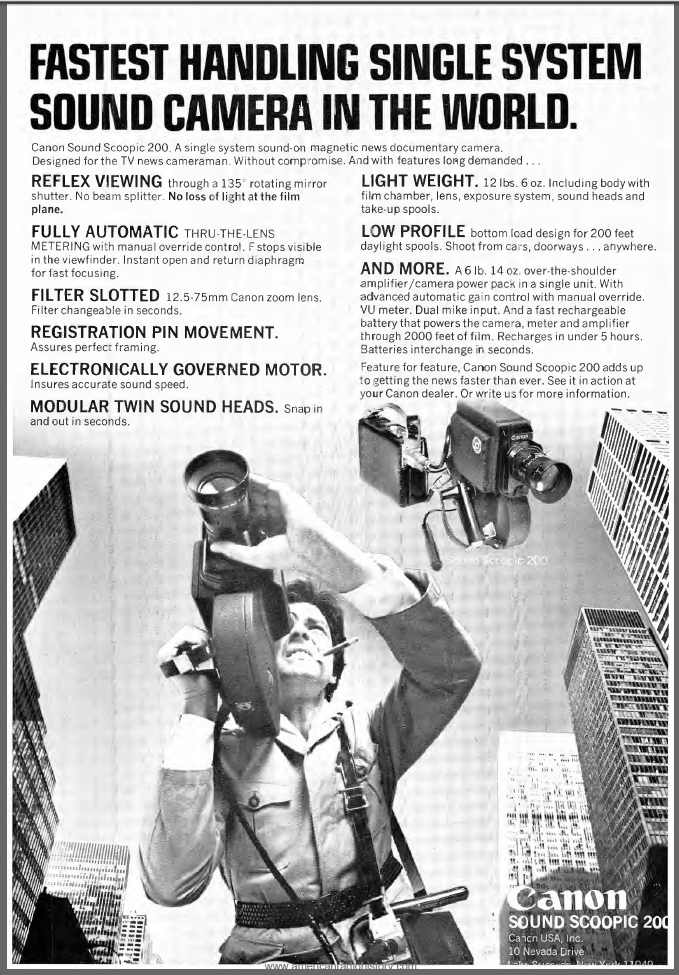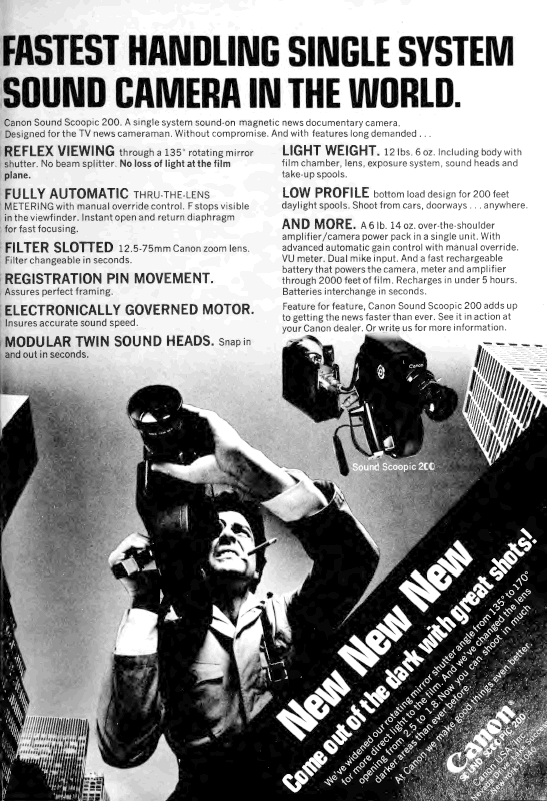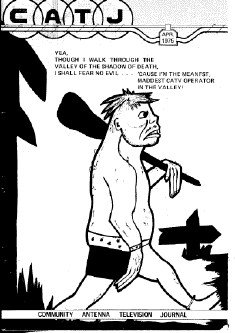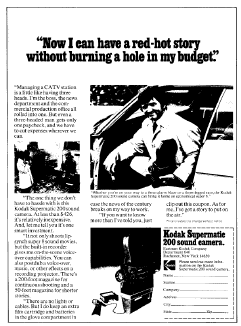|
|
Bell and Howell Motion Picture
Equipment for Television Stations |
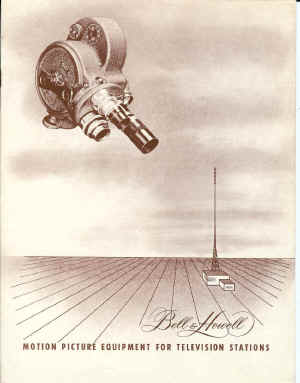 |
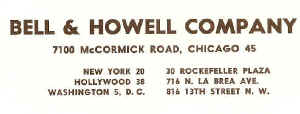
_________(Inside front cover)
|
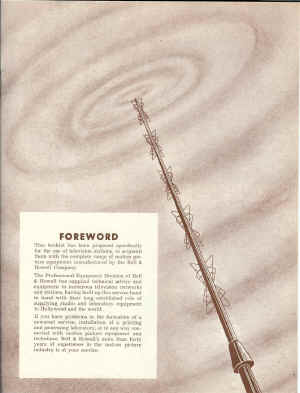
FOREWORD
This booklet has been prepared specifically for the use
of television stations, to acquaint them with the complete range of motion
picture equipment manufactured by the Bell & Howell
Company.
The Professional Equipment Division of Bell &
Howell has supplied technical advice and equipment to numerous television
networks and stations, having built up this service hand in hand with
their long established role of supplying studio and laboratory equipment
to Hollywood and the world.
If you have problems in the formation of a newsreel service,
installation of a printing and processing laboratory, or in any way
connected with motion picture equipment and technique, Bell & Howell's
more than forty years of experience in the motion picture industry is at
your service
|
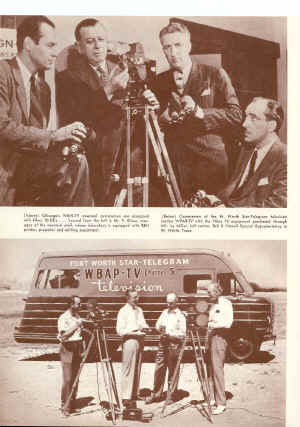
(Above) Chicago's WGN-TV newsreel cameramen are
equipped with Filmo 70-DE's . . . Second from the left is Mr. F. Giese,
manager of the newsreel staff, whose laboratory is equipped with B&H
printer, projector and editing equipment.
(Below) Cameramen of the Ft. Worth Star-Telegram television station
WPAB-TV with the Filmo 70 equipment purchased through Mr. Ira Miller, left
center, Bell & Howell
Special Representative in Ft. Worth, Texas.
|
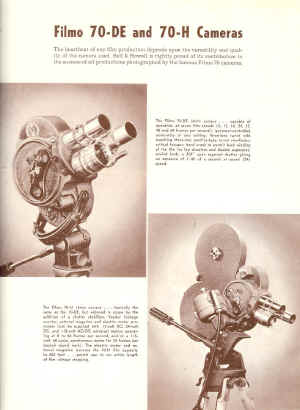
Filmo 70-DE and 70-H Cameras
The heartbeat of any film production
depends upon the versatility and quality of the camera used. Bell &
Howell is rightly proud of its contribution to the success of all
productions photographed by the famous Filmo 70 cameras.
The Filmo 70-DE I6mm camera . . .
capable of operation at seven film speeds (8, 12, 16, 24, 32, 48 and 64
frames per second); governor-controlled accurately at any setting;
three-lens turret with matching three-lens positive-type turret
viewfinder; critical focuser; hand crank to permit back winding of the
film for lap dissolves and double exposures; rewind knob; a 2040
open segment shutter giving an exposure of 1/40 of a second at
sound (24) speed.
The Filmo 70-H 16mm camera . . . basically the same as the 70-DE, but
widened in scope by the addition of a shutter stabilizer, Veeder footage
counter, external magazine and electric motor provisions (can be supplied
with 12-volt DC, 24-volt DC, and 115-volt AC-DC universal motors operating
at 8 to 64 frames per second, and/or a 115volt, 60-cycle, synchronous
motor for 24 frames per second sound work). The electric motor and
external magazine increase the 70-H film capacity to 400 feet . . . permit
user to run entire length of film without stopping.
|
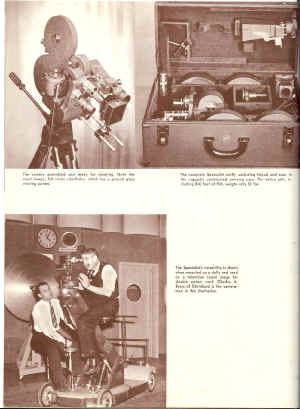
The camera assembled and ready for shooting. Note the
erect image, full vision viewfinder, which has a ground glass viewing
screen.
The complete Specialist outfit, excluding tripod and
case, in the ruggedly constructed carrying case. The entire unit,
including 800 feet of film, weighs only 52 lbs.
The Specialist's versatility is shown when mounted on a dolly and used
on a television sound stage for double system work. Charles A. Byers of
Cleveland is the cameraman in this illustration.
|
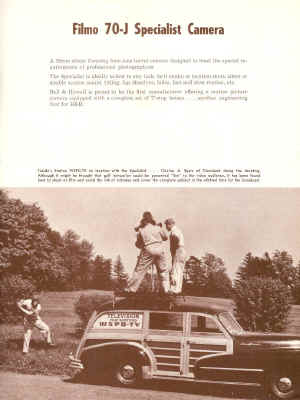
Filmo 70·J Specialist Camera
A 16mm direct focusing four-lens turret camera designed
to meet the special requirements of professional photographers.
The Specialist is ideally suited to any task, be it
studio or location shots, silent or double system sound, titling, lap
dissolves, fades, fast and slow motion, etc.
Bell & Howell is proud to be the
first manufacturer offering a motion picture camera equipped with a
complete set of T -stop lenses . . . another engineering first for
B&H.
Toledo's Station WSPD-TV on location with the Specialist . . . Charles
A. Byers of Cleveland doing the shooting. Although it might be thought
that golf instruction could be presented "live" to the video
audience, it has been found best to shoot on film and avoid the risk of
mistakes and cover the complete subject in the allotted time for the
broadcast.
|
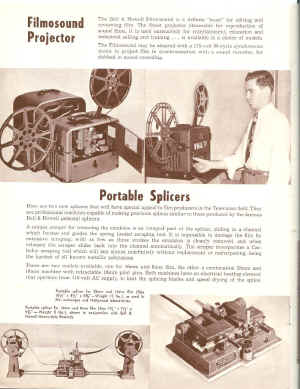
Filmosound Projector
The Bell & Howell
Filmosound is a definite "must" for editing and reviewing film.
The finest projector obtainable for reproduction of sound films, it is
used extensively for entertainment, education and industrial selling and
training . . . is available in a choice of models.
The Filmosound may be adapted with a 115-volt 50-cycle
synchronous motor to project film in synchronization with a sound
recorder, for dubbed in sound recording.
Portable Splicers
Here are two new splicers that will have special appeal
to film producers in the Television field. They are professional machines
capable of making precision splices similar to those produced by the
famous Bell & Howell
pedestal splicers.
A unique scraper for removing the emulsion is an
integral part of the splicer, sliding in a channel which locates and
guides the spring loaded scraping tool. It is impossible to damage the
film by excessive scraping; with as few as three strokes the emulsion is
cleanly removed, and when released the scraper slides back into the
channel automatically. The scraper incorporates a Carboloy scraping tool
which will last almost indefinitely without replacement or resharpening,
being the hardest of all known metallic substances.
There are two models available, one for 16mm and 8mm
film, the other a combination 35mm and 16mm machine with retractable 16mm
pilot pins. Both machines have an electrical heating element that operates
from 110-volt AC supply, to heat the splicing blades and speed drying of
the splice.
Portable splicer for 35mm and 16mm film (Size 10 1/2"'
x 8 1/2h" x 4 3/4"-Weight 12 Ibs.). as used
in film exchanges and Hollywood laboratories.
Portable splicer for 16mm and 8mm film (Size 7 1/2h" x
7 1/2h" x 4 3/4" - Weight Sibs.), shown in
conjunction with Bell & Howell
Heavy-duty Rewinds.
|
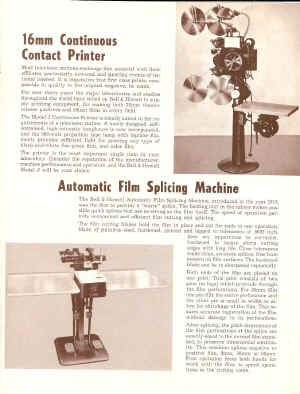
16mm Continuous
Contact Printer
Most television stations
exchange film material with their affiliates, particularly newsreel and
sporting events of national interest. It is imperative that first class
prints, comparable in quality to the original negative, be made.
For over thirty years
the major laboratories and studios throughout the world have relied on
Bell & Howell to supply
printing equipment, for making both 35mm theater release positives and
16mm films in every field.
The Model J Continuous
Printer is ideally suited to the requirements of a television station. A
newly designed, selfcontained, high-intensity lamphouse is now
incorporated, and the 300-watt projection type lamp with biplane filaments
provides sufficient light for printing any type of black-and-white
fine-grain film, and color film.
The printer is the
most important single item in your laboratory. Consider the reputation of
the manufacturer, machine performance and operation, and the Bell &
Howell Model J will be your choice.
Automatic Film
Splicing Machine
The Bell & Howell
Automatic Film Splicing Machine, introduced in the year 1915, was the
first to provide a "warm" splice. The heating unit in the
splicer makes possible quick splices that are as strong as the film
itself. The speed of operation permits economical and efficient film
cutting and splicing.
The film cutting blades
hold the film in place and cut the ends in one operation. Made of
stainless steel, hardened, ground and lapped to tolerances of .0002 inch,
they are impervious to
corrosion, hardened to insure sharp cutting edges with long life. Close
tolerances make clean, accurate splices, free from cement on film
surfaces. The hardened blade can be re-sharpened repeatedly.
Both ends of the film are
placed on one pilot. This pilot consists of two pins (or legs) which
protrude through the film perforations. For 35mm film one pin fills the
entire perforation and the other pin is small in width to allow for
shrinkage of the film. This insures accurate registration of the film
without damage to its perforations.
After splicing, the pitch dimensions of the
film perforations at the splice are exactly equal to the normal film
standard, to preserve dimensional continuity. This machine splices
negative or positive film, 8mm, 16mm or 35mm. Foot operation frees both
hands for work with the film, to speed operations in the cutting room.
|

16mm Projection Equipment for
Television Transmission
Bell & Howell
Filmoarc projector head with General Electric Synchro-lite illumination.
The resources of the General Electric Company and the
Bell & Howell
Company have been combined to produce a 16mm projector engineered
specifically to meet the requirements of film reproduction by television.
The basic mechanism consists of a Bell &
Howell Filmoarc projector and
special stand, on which is mounted a General Electric Synchro-lite unit
operating on the entirely new principle of pulse illumination. The shutter
of the projector has been dispensed with, since the light is not
illuminated during the period when the film is being advanced. The
Synchro-lite flashes upon signal from the station's pulse generator, and
is operative only 5% of the time instead of 100% as with a constantly
burning arc or incandescent lamp.
The Filmoarc projector is used extensively in theaters,
schools, institutions, etc., where theater quality projection is
imperative. The Bell & Howell
intermittent mechanism is world famous for its reliability and efficiency,
and full film protection is assured by the "floating film"
construction throughout.
This combination of a Bell & Howell
Filmoarc projector with a General Electric Synchrolite unit has produced a
16mm projector of superb quality, engineered for the television projection
booth.
|
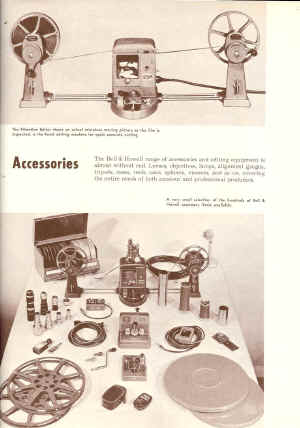
The Filmotion Editor shows an actual miniature
moving picture as the film is inspected, is the finest editing machine for
quick accurate cutting.
Accessories
The Bell & Howell range
of accessories and editing equipment is almost without end. Lenses,
objectives, lamps, alignment gauges, tripods, cases, reels, cans, splicers,
viewers, and so on, covering the entire needs of both amateur and
professional producers.
A very small selection of the hundreds of
Bell & Howell accessory items available. |

BELL & HOWELL COMPANY
7100 McCORMICK ROAD • CHICAGO 45,
ILLINOIS
30 ROCKEFELLER PLAZA • NEW YORK 20
716 N. LA BREA AVENUE • HOLLYWOOD 38
816 13TH STREET, N. W. • WASHINGTON 5,
D. C.
FORM 4276 Cbdi
9832 Printed in
U. S. A. |
| |
|
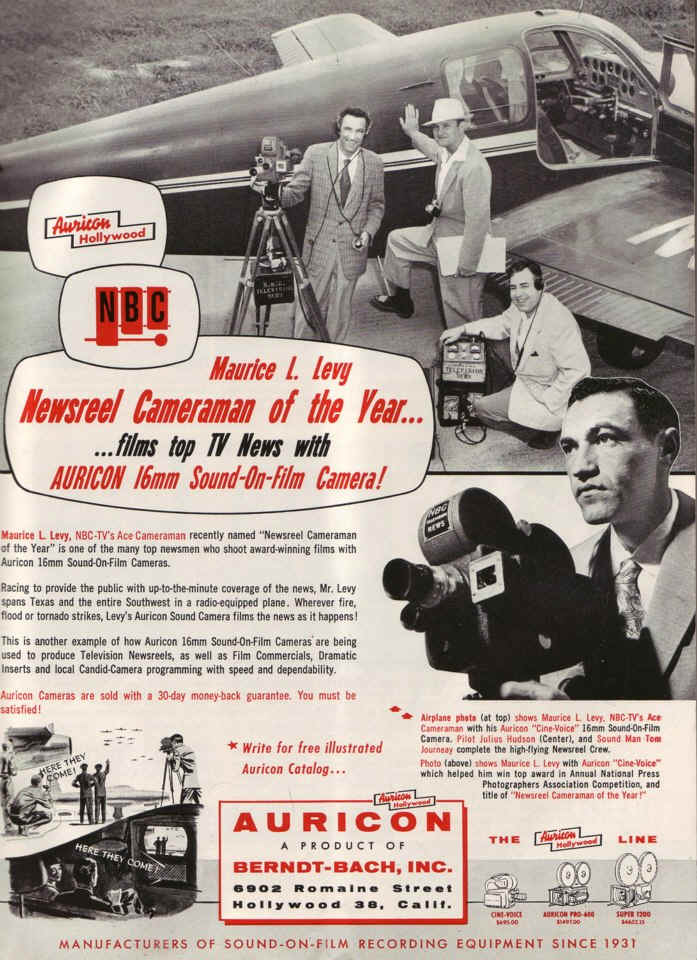
|
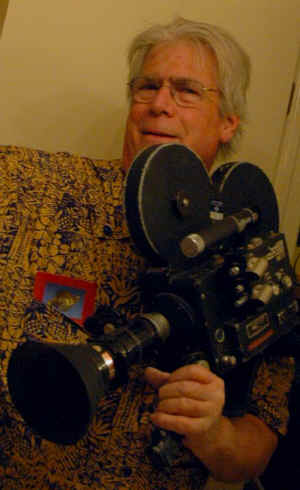 The
Frezzi LW16 The
Frezzi LW16
The Frezzi LW16 is a
sound on film camera designed for the newsfilm days when news stories were
shot on film. It's a non reflex camera - The 12 to 120 Angenieux has a
dogleg viewfinder.
It uses 16mm film with a magnetic sound stripe (no longer made).
This camera is uses an Auricon movement but has better self-contained
amplifier and the nice use of the 400 foot magazines (Mitchell type) we
are looking for similar cameras to round out the news film camera display
- Ed Sharpe
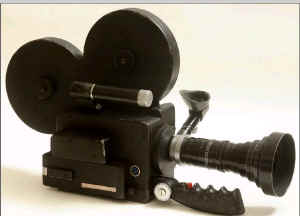
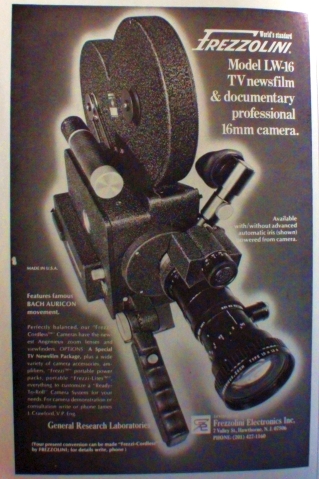 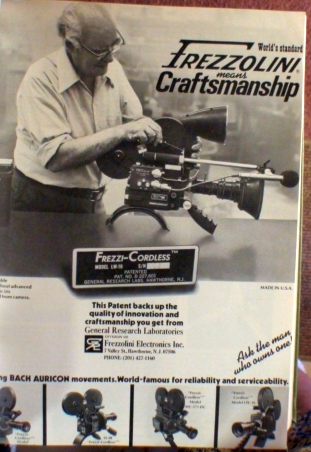
|
|
Before the Mini-cam news
video camera there was... |
|
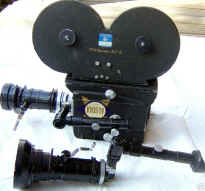 Gordon Yoder Gordon Yoder
16mm Bach-Auricon Sound-On-Film Camera.
Professional CINE TELEVISION CAMERA. This is an
original Gordon Yoder, model 31507. Yoder, who died in October,
2005, was the owner and operator of Gordon Yoder Inc. in Dallas, Texas. He
developed a modification for the 16mm Bach-Auricon sound-on-film camera,
expanding its film capacity to hold larger film magazines, incorporating a
transistorized magnetic sound recording system, and using 12 volt synch
motors. Many considered the Yoder camera a standard of the news film
industry.
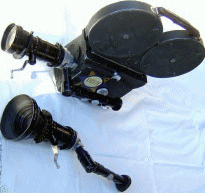 Yoder’s converted camera meant that photojournalists
could shoot longer than 2 minutes and 45 seconds. Before magnetic sound on
film was invented, cameras weren’t portable. Sound was recorded
optically. This required a big, heavy conversion box. TV cameramen had to
carry not only heavy battery packs (lead-acid, because Ni-Cads had not yet
been invented), but also an inverter to convert the electricity to
alternating current (AC). The Yoder-converted cameras, and the CP-16s that
followed, revolutionized the way news was covered. Yoder’s converted camera meant that photojournalists
could shoot longer than 2 minutes and 45 seconds. Before magnetic sound on
film was invented, cameras weren’t portable. Sound was recorded
optically. This required a big, heavy conversion box. TV cameramen had to
carry not only heavy battery packs (lead-acid, because Ni-Cads had not yet
been invented), but also an inverter to convert the electricity to
alternating current (AC). The Yoder-converted cameras, and the CP-16s that
followed, revolutionized the way news was covered.
This
functional Camera weighs 10 lbs. Dimensions: 9 ¼” x 5” x 7”. This
rare Camera comes in its original 27” x 10 ¾” x 15 ¾”, 12 lbs
trunk (when empty). The auction also includes 5 film canisters, Two (2)
200mm Telephoto P. Angenieux Paris Lenses. One lens is a P.
Angenieux-ZOOM, TYPE 10 X 12A No. 1209506; F.12-120mm 1:2.2. It is
equipped with 72 M 9 TIFFEN Adapter Ring, Series 9, U.S.A. Second lens is
the same except for serial number 1255457. Both Lens have EMS TV LEFF II
hand written on them.
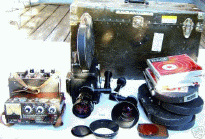 Also included are two (2) All
Transistor High Fidelity 16mm SOUND-ON-FILM AMPLIFIERS Filmagnetics by
Bach Auricon, Filter, and BASF Blank SP52 Tapes. This camera originally
belonged to KVOS-TV which can be seen in Bellingham, Washington, and
British Columbia, Canada. The Camera works. However, we did not
get any power cords. perhaps someone has cords we can use with this? Also included are two (2) All
Transistor High Fidelity 16mm SOUND-ON-FILM AMPLIFIERS Filmagnetics by
Bach Auricon, Filter, and BASF Blank SP52 Tapes. This camera originally
belonged to KVOS-TV which can be seen in Bellingham, Washington, and
British Columbia, Canada. The Camera works. However, we did not
get any power cords. perhaps someone has cords we can use with this?
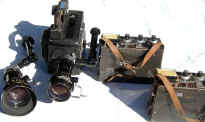 We are looking for manuals, parts and a spare camera body....anyone
have any leads? We are looking for manuals, parts and a spare camera body....anyone
have any leads?
|
|

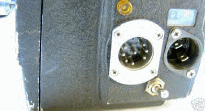
|
|
This interesting patent regarding a completely
self-contained
shoulder harness & power supply designed for
use with an Auricon
camera was found by a friend searching the Google
Patent Database.
In addition to supporting the camera and amplifier,
it also contains
batteries and an inverter to power it.
Pat. No_2873645 |
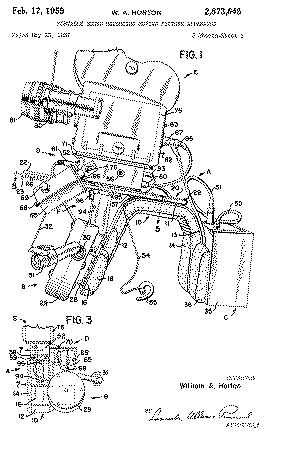
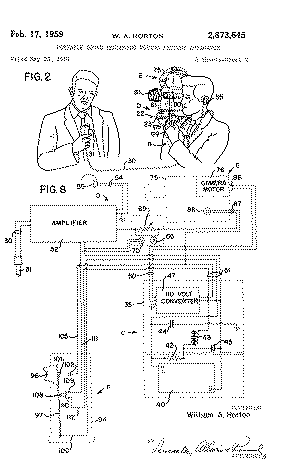
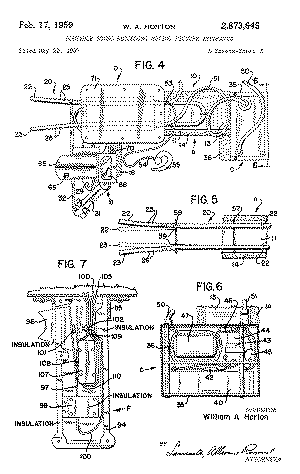
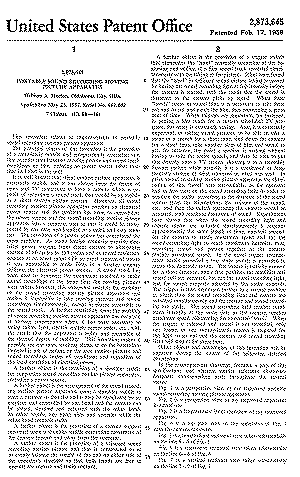
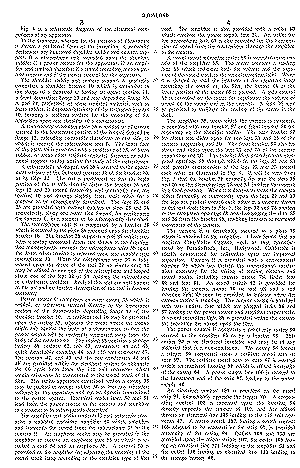
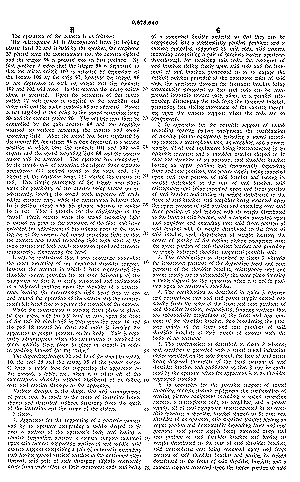
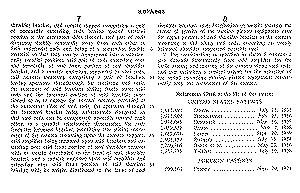
|
| |
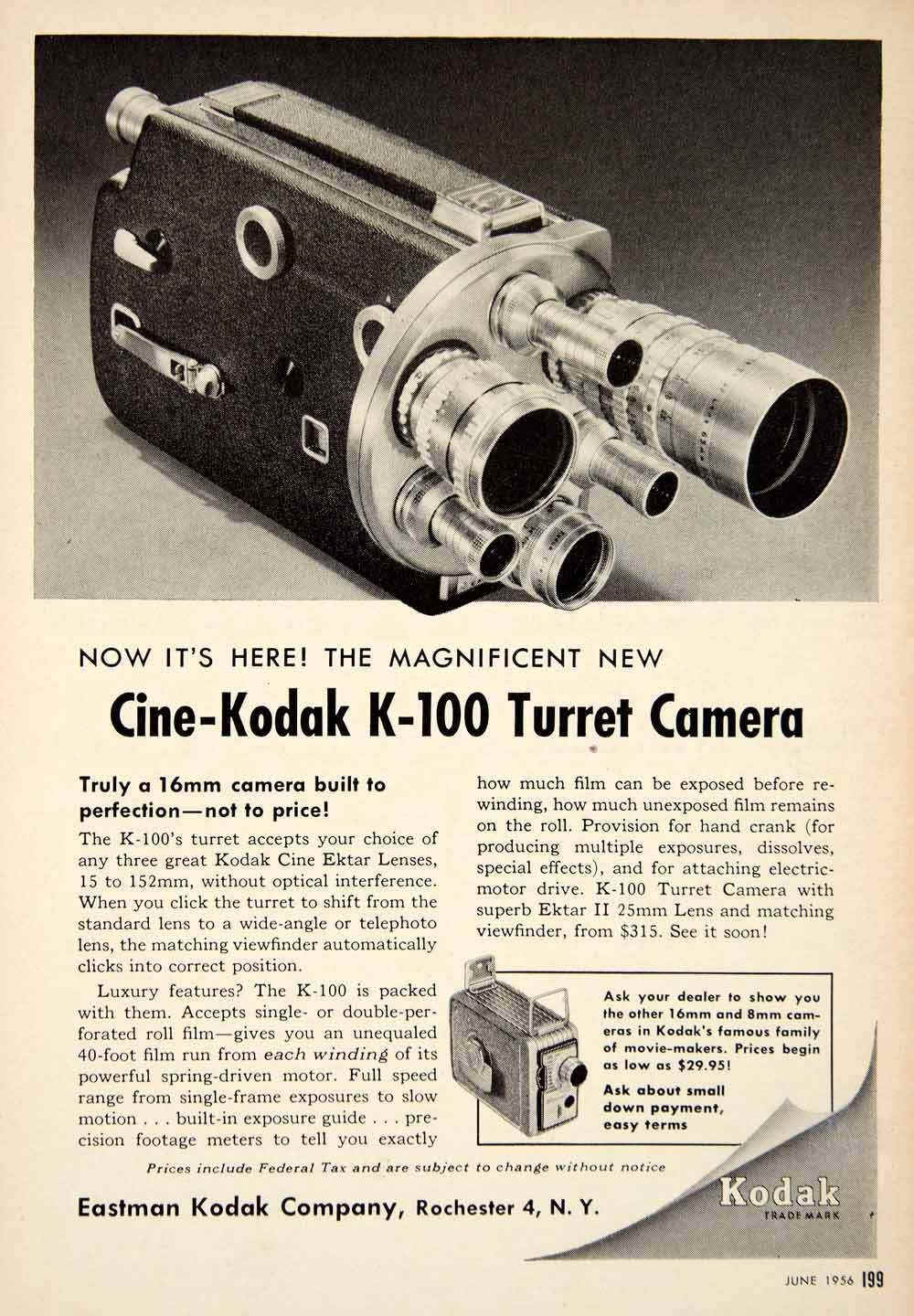
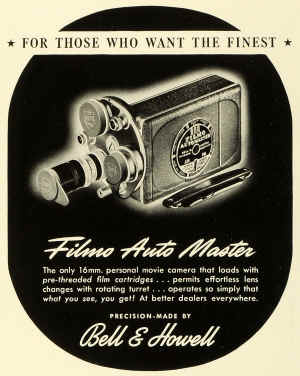
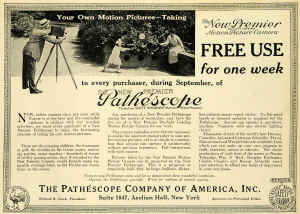
1941
Premiere Pathescope - 1921
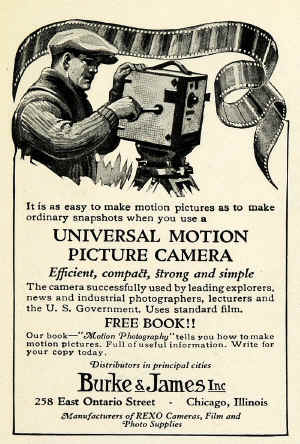
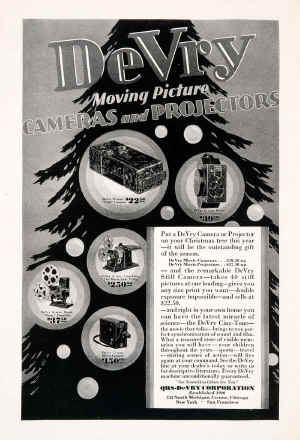
1921 Burke and Burk and
James
DeVry -1929
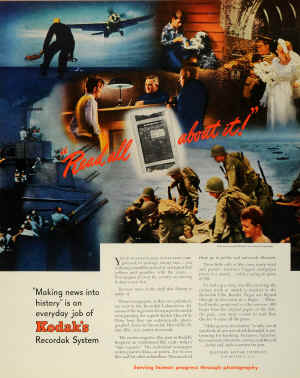
|
|
![]()
